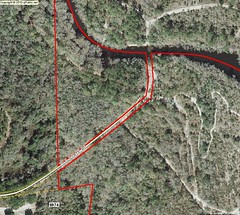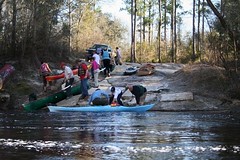 Update 2013-01-25 9:48 AM: fixed an error and added some further detail. -jsq
Update 2013-01-25 9:48 AM: fixed an error and added some further detail. -jsq
Citing unspecified sources of information about water rights,
the Lowndes County Commission voted to move to a hearing to
abandon a road to a river they didn’t name, but which
happens to be: the Alapaha River (it was named this time).
This was at the
Regular Session of 22 January 2013.
See also the
Work Session the morning of the same day.
7.b. Abandonment of a portion of Old State Road (CR 16)
County Engineer Mike Fletcher describe the case like this:
Georgia Statute says that for an initial determination
that the section of county road has for any reason
ceased to be used by the public to the extent that
no substantial public purpose is served by it,
or that its removal from the county road system
is in
the public’s best interest.
And just to remind you, as we spoke yesterday,
the bridge that goes across the Alapaha River has been washed out;
it has not been replaced,
so there is no access across the river to Lanier County.
Commissioner Demarcus Marshall remarked that this same
item had been voted down 26 October 2010(?).
Chairman Bill Slaughter asserted that the applicant had previously gotten
permission to close the road and was merely asking to extend the length;
he was corrected by staff (I think by County Manager Joe Pritchard) saying
no, it wasn’t approved.
Why doesn’t staff brief the Commission and the public on the history of a case
like this when it comes up again?
Commissioner Joyce Evans said
 It was not approved because of different circumstances.
I think during that time, Mr. Fletcher,
you researched it all and you got the information
that we needed.
And that was the reason it was not approved;
we didn’t have the information that we needed
about the water rights.
Since then we have received that.
It was not approved because of different circumstances.
I think during that time, Mr. Fletcher,
you researched it all and you got the information
that we needed.
And that was the reason it was not approved;
we didn’t have the information that we needed
about the water rights.
Since then we have received that.
County Engineer Mike Fletcher added:
This is not considered a navigable waterway,
so therefore Mr. Connell owns the bottom of the riverbed,
so his property actually goes into the river, and not to the
high water mark.
Marshall said he’d heard from a constituent
Continue reading →
 at Hotchkiss Landing from late 2010 through at least early 2012?
Why did Code Enforcement do nothing about it?
at Hotchkiss Landing from late 2010 through at least early 2012?
Why did Code Enforcement do nothing about it?






















